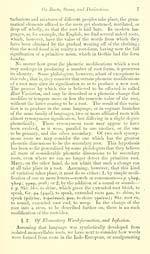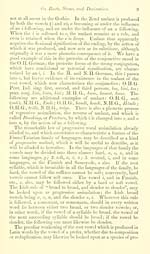Blair Collection > Celtic studies
(38)
Download files
Complete book:
Individual page:
Thumbnail gallery: Grid view | List view

8 Introduction.
languages, to wliicli family tlie following pages will exclusively
refer. The development of words from roots may be called
Word-formation^ but tlie elementary words tlius formed must
undergo further modification, in order to express the varying
relations of speech. Thus, a Verb must have special contri-
vances to express time, person, etc. ; and the Noun, number and
case, etc. This further modification is called Inflexion, or Word-
bending. The processes by which elementary Word-formation
and Inflexion are effected are fundamentally the same ; they are —
1. Internal phonetic change, which can only affect the root-
vowel, as the change of a consonant would necessarily
produce a change in the symbolic value of the root.
2. Addition of phonetic material to the root, which may be of
two kinds :
a. Such as springs from the root itself; or Duplication.
b. Affixes ; wliich may be Prefixes or Suffixes, but esj)e-
cially the latter. These Affixes may be :
a. Single sounds or syllables, which only are used as
formational elements of words, having by themselves
no signification in the fully-formed language, and do
not consequently occur isolated in it.
j3. Affixes which possess of themselves a distinct mean-
ing, and consequently may occur as isolated words
in the language.
In the Semitic languages, vowel-change is a predominant
mode of word-formation and word-inflexion. In the Indo-Euro-
pean languages it only appears as Ablaut;^ that is, an interchange
in the body of the root of the primitive pure short vowels, a, i,
u, but, at a later period, of the newer vowels e and o also, which
were produced by the softening of the primitive vowels. This
kind of vocalic change (ablaut) appears to have been a funda-
mental principle of word-formation in the Teutonic languages.
The vowel change known as Umlmit is the change or obscura-
tion of the fundamental root vowels a, o, u, into the impiu-e or
obscure vowels, a, 0, il, under the regressive assimilating influ-
ence of i (or ?«) in the syllabic immediately following the root.
In the Teutonic languages, umlaut by means of n only occurs in
the Old Norse, in which it has been fully developed ; umlaut does
* Wherever special technical terms are invented in any language to express
certain definite ideas, they should he rctahii'd in translating from that language,
if the laws of euphony of the language into which the translation is made
at all admit of it. The words (i/i/ai/l, iinilunt, variant, nachldiit, (inlaii/, inlaut,
and aiisldut are convenient terms, and ))ettt'r than any M-hich could be made out
of Greek words. I have consequently used them throughout. Ablaut, undaut,
vorhmt, and nachlaut are fully explained wliere they first occur. Anlaut is the
initial sound, and auslaut is the final sound of a word.
languages, to wliicli family tlie following pages will exclusively
refer. The development of words from roots may be called
Word-formation^ but tlie elementary words tlius formed must
undergo further modification, in order to express the varying
relations of speech. Thus, a Verb must have special contri-
vances to express time, person, etc. ; and the Noun, number and
case, etc. This further modification is called Inflexion, or Word-
bending. The processes by which elementary Word-formation
and Inflexion are effected are fundamentally the same ; they are —
1. Internal phonetic change, which can only affect the root-
vowel, as the change of a consonant would necessarily
produce a change in the symbolic value of the root.
2. Addition of phonetic material to the root, which may be of
two kinds :
a. Such as springs from the root itself; or Duplication.
b. Affixes ; wliich may be Prefixes or Suffixes, but esj)e-
cially the latter. These Affixes may be :
a. Single sounds or syllables, which only are used as
formational elements of words, having by themselves
no signification in the fully-formed language, and do
not consequently occur isolated in it.
j3. Affixes which possess of themselves a distinct mean-
ing, and consequently may occur as isolated words
in the language.
In the Semitic languages, vowel-change is a predominant
mode of word-formation and word-inflexion. In the Indo-Euro-
pean languages it only appears as Ablaut;^ that is, an interchange
in the body of the root of the primitive pure short vowels, a, i,
u, but, at a later period, of the newer vowels e and o also, which
were produced by the softening of the primitive vowels. This
kind of vocalic change (ablaut) appears to have been a funda-
mental principle of word-formation in the Teutonic languages.
The vowel change known as Umlmit is the change or obscura-
tion of the fundamental root vowels a, o, u, into the impiu-e or
obscure vowels, a, 0, il, under the regressive assimilating influ-
ence of i (or ?«) in the syllabic immediately following the root.
In the Teutonic languages, umlaut by means of n only occurs in
the Old Norse, in which it has been fully developed ; umlaut does
* Wherever special technical terms are invented in any language to express
certain definite ideas, they should he rctahii'd in translating from that language,
if the laws of euphony of the language into which the translation is made
at all admit of it. The words (i/i/ai/l, iinilunt, variant, nachldiit, (inlaii/, inlaut,
and aiisldut are convenient terms, and ))ettt'r than any M-hich could be made out
of Greek words. I have consequently used them throughout. Ablaut, undaut,
vorhmt, and nachlaut are fully explained wliere they first occur. Anlaut is the
initial sound, and auslaut is the final sound of a word.
Set display mode to: Large image | Transcription
Images and transcriptions on this page, including medium image downloads, may be used under the Creative Commons Attribution 4.0 International Licence unless otherwise stated. ![]()
| Early Gaelic Book Collections > Blair Collection > Celtic studies > (38) |
|---|
| Permanent URL | https://digital.nls.uk/75771600 |
|---|
| Description | A selection of books from a collection of more than 500 titles, mostly on religious and literary topics. Also includes some material dealing with other Celtic languages and societies. Collection created towards the end of the 19th century by Lady Evelyn Stewart Murray. |
|---|
| Description | Selected items from five 'Special and Named Printed Collections'. Includes books in Gaelic and other Celtic languages, works about the Gaels, their languages, literature, culture and history. |
|---|

